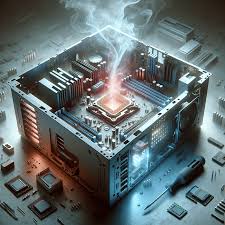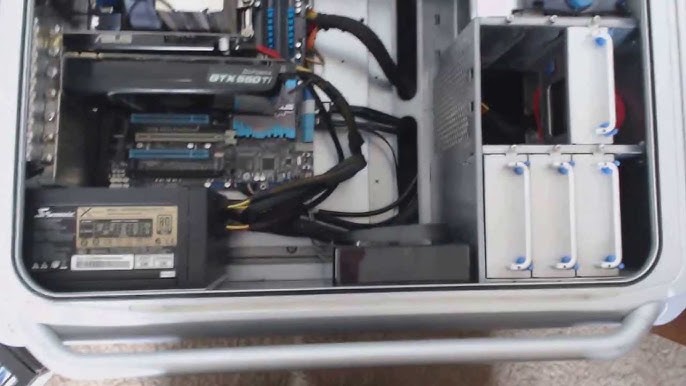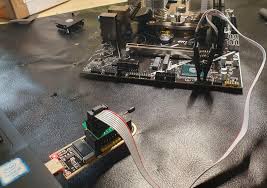When my motherboard bricked, I felt utterly stuck—my PC wouldn’t even turn on. After hours of troubleshooting, I discovered it was due to a failed BIOS update. I had to replace the motherboard, but the experience taught me the importance of backup and careful updates!
If your motherboard is bricked, it often stops working due to a failed BIOS update. Your computer won’t start, and you may need to repair or replace the motherboard to fix it.
This article will discuss “What Happens if Your Motherboard is Bricke?”.
Table of Contents
Understanding What a Bricked Motherboard Means:

A bricked motherboard means it no longer works, often due to a failed update or hardware issue. Your computer won’t start, and fixing it might require professional help or replacing the motherboard. Constantly update carefully to avoid this problem.
Read More: Can My Motherboard Run 4070? – What You Need to Know!
What happens when your motherboard is bricked?
When the motherboard is bricked, it completely refuses to function, and your computer will not turn on. This usually happens because of a failed BIOS update, power surge, or hardware malfunction. You may need to reset the BIOS, reflash firmware, or replace the motherboard to repair.
What does it mean when a motherboard is bricked?
A motherboard is bricked when it stops working and will not boot or function. This is usually caused by failed BIOS updates, power surges, or other hardware damage. A “bricked” motherboard is as helpful as a brick but cannot be easily repaired.
Common Causes of a Bricked Motherboard:
1. Failed BIOS Update:
A failed BIOS replacement can prevent your laptop from starting properly. It typically occurs if the replacement procedure is interrupted or corrupted. To repair it, you could want to reset or reflash the BIOS.
2. Power Surge:
An energy surge occurs when the electric delivery on your gadgets unexpectedly increases. This can harm your laptop’s additives and the motherboard, causing it to work. Using a surge protector can assist save you this.
3. Overheating:
Overheating occurs when a laptop or tool gets too hot regularly due to dust, bad ventilation, or overuse. If not addressed, it can cause overall performance issues, damaged parts, or even machine crashes.
4. Physical Damage:
Physical harm to a motherboard happens when it’s exposed to impacts, heat, or liquid. This can cause additives to prevent functioning, leading to machine disasters or the need for an alternative to repair functionality.
How do I know if I fried my motherboard?
If the motherboard is fried, the computer might not turn on, or it can show a blank screen. Your computer may even have strange beeps or smells of burning. Check some components like the CPU, RAM, or power supply, as they may have a problem that affects it.
Can a bricked motherboard damage other components?
A bricked motherboard doesn’t damage other components; it only may cause problems. For instance, if a motherboard fails to power up or work as it should, this could prevent the CPU, RAM, or other storage devices from working. In sporadic cases, power surges may hurt other parts.
How to Avoid Bricking Your Motherboard in the Future:
1. Backup BIOS Before Updating:
Before updating your BIOS, continually create a backup. This guarantees that if something goes incorrect during the update, you may repair your device to its preceding running country without having to update your motherboard.
2. Use Surge Protectors:
Using surge protectors can help prevent damage to electronics from electricity surges resulting from lightning or electric issues. They can also keep your gadgets safe by blocking off extra voltage and keeping them secure from surprising electricity spikes.
3. Maintain Proper Cooling:
Maintaining proper cooling is vital to save your motherboard from overheating. Make sure your PC has adequate airflow, smooth fans, and thermal paste at the CPU to preserve the entirety of going for walks quickly and keep away from harm.
Can a bricked motherboard be repaired?

Yes, a bricked motherboard can sometimes be repaired. It depends on the cause. If it’s due to a failed BIOS update, you might be able to recover it by re-flashing the BIOS. However, in some cases, replacing the motherboard may be necessary.
Read More: White Light On Motherboard – Quick Solutions Inside!
Is a bricked motherboard covered under warranty?
A bricked motherboard may be covered under warranty if the issue is due to a manufacturing defect. However, if the damage was caused by user error, like an improper BIOS update, it may not be covered. Always check the warranty terms for specific details.
Can you flash the BIOS on a bricked motherboard?
If the cause of the bricked motherboard is a corrupted BIOS, you can sometimes flash it. To do that, you would need a USB drive with the correct version of the BIOS and a special recovery method, such as using the built-in recovery feature of a motherboard or a programmer tool.
How do I tell if I’ve bricked my motherboard?
You might have bricked your motherboard, so your computer fails to turn on, show anything on the monitor, or give any indication of being turned on. It also makes some weird beeping sounds or freezes during startup. To resolve this situation, your motherboard might already be bricked and must be either repaired or replaced.
Did I brick my motherboard?
You may have bricked it if your motherboard does not turn on or displays no indication of life. This may occur due to a bad BIOS update, a power surge, or other reasons. Check connections, reset the BIOS, or consult a technician to confirm and fix.
What happens if your motherboard is bricked?
If your motherboard is bricked, your computer won’t turn on or work properly. This usually happens due to a failed BIOS update or hardware failure. In most cases, you may need to replace or fix the motherboard using specific recovery methods.
Signs of a bricked motherboard:
The signs include the computer failing to start up, no display on the screen, and even odd beeping sounds. This may happen after a failed update or hardware damage. System freezing or crashing during startup could also be noticed.
How do you fix a bricked motherboard?
To restore a bricked motherboard, one should start by resetting the BIOS by clearing the CMOS. If that does not work, reflash the BIOS using a USB drive with the correct firmware. Sometimes, you must replace the motherboard if it cannot be repaired.
How much does it cost to replace a bricked motherboard?
Typically, a bricked motherboard would be replaced and cost anywhere between $100 and $400, depending on the brand and model of your computer. There’s also the labour fee if you’re having someone repair it. In some cases, it is cheaper to replace than to repair.
Can you prevent a motherboard from becoming bricked?

Yes, preventing a motherboard from being bricked is possible by avoiding unsafe BIOS updates, using reliable power supplies, keeping your system free from viruses, updating drivers, and exercising caution when overclocking or installing hardware.
Read More: How Do I Know If My Motherboard Is Fried – Here’s What To Look For First!
FAQs:
1. How Do I Know if My Motherboard Is Bricked?
Well, a motherboard may be considered bricked if your PC refuses to start, shows error codes, or continues to be black. It may even generate extraordinary beeping while booting.
2. Can a Bricked Motherboard Be Recovered?
Yes, it’s far more feasible to get a better-bricked motherboard.
A bricked motherboard can occasionally be repaired by resetting the BIOS or flashing firmware. However, a brand-new motherboard can be necessary if the harm is irreversible.
3. What Bricks a Motherboard?
A motherboard can grow to be bricked because of failure whilst updating the BIOS, electricity surge, failed hardware, or incorrect setup of components. In a few cases, overheating and static strength ultimately harm a motherboard.
4. How Do I Avoid Bricking My Motherboard?
You must avoid risky BIOS flashing, use a surge protector, and ensure the right hardware setup, among other things. Do no longer make primary modifications inside the gadget without backing up important statistics.
5. Can a Faulty Power Supply Brick a Motherboard?
Yes, a defective or volatile electricity supply can cause electricity surges that harm the motherboard. Applying an outstanding electricity supply is crucial to ensure your gadget’s protection.
6. Is a Bricked Motherboard Covered Under Warranty?
Many motherboard warranties cover troubles due to production defects; however, harm from wrong use or overclocking won’t be covered. Always check the guarantee phrases for particular details.
Conclusion:
If your motherboard is hisbricked, it will be an expensive, frustrating prospect, but by taking due care and precautions, you can minimise the risk of such an event. Always ensure safe BIOS updates, use reliable power sources, and handle your hardware components with care. If your motherboard does become bricked, assess whether repair is necessary or a replacement is required. Staying proactive with regular maintenance and backups will help avoid the most common causes of motherboard failure.

This is very fascinating, You’re an excessively skilled blogger. I have joined your feed and look forward to in search of extra of your excellent post. Also, I’ve shared your website in my social networks!
My programmer is trying to convince me to move to .net from PHP. I have always disliked the idea because of the expenses. But he’s tryiong none the less. I’ve been using Movable-type on numerous websites for about a year and am anxious about switching to another platform. I have heard excellent things about blogengine.net. Is there a way I can transfer all my wordpress content into it? Any help would be greatly appreciated!